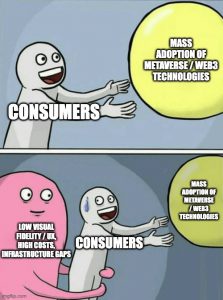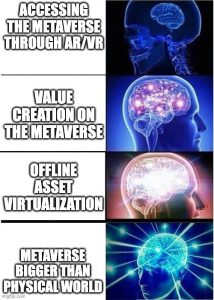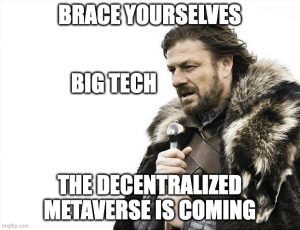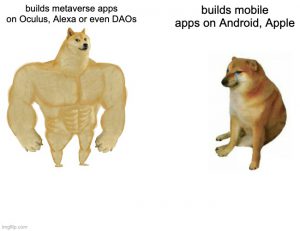When Mark Zuckerberg announced Facebook’s transition to Meta at Connect 2021, virtual reality got a facelift with the “metaverse” and discussions have been rekindled over this future of the internet. That said, virtual environments and the technologies around them have long been around and evolving, even before Facebook came out of a university dormitory. But what makes the spotlight on the metaverse more significant this time around is the parallel momentum of adjacent technologies and relevant behaviors:
- Contactless, Remote, and Online Normal: We’re living in a post-pandemic world where the normal is contactless and remote, and more people have been spending more time on online platforms.
- Virtual Environments Investing in Social: Gaming companies like Roblox, Minecraft and Epic have been riding this wave of more people spending time online (e.g. Roblox with 40 million DAU and more than 90% QoQ growth over 2020, the milestone in-game tour of Fortnite done by Travis Scott drawing over 27 million players) and investing heavily into increasingly immersive experiences and environments that can handle increasing numbers of people on the same server.
- Decentralized Transactions for Virtual Assets: More venture money going into decentralized finance fuels the exploration into use cases beyond the cryptocurrencies themselves (i.e. trading and holding) and into transactions for virtual and tokenized assets (e.g. NFTs).
Our founding managing partner Yinglan Tan shares some of his early thoughts on the metaverse at a seminar talk for the book launch of Paul Schulte’s latest treatise into next-generation financial technology, Money Metaverse: How Crypto is Reinventing Finance & Property and Unlocking Value via Tokenization. (We previously had Paul on our podcast share his perspective as a seasoned equity researcher, professor, and fintech author on the implications of blockchain technology on emerging markets like Southeast Asia.)
As with most talks (you can read insights from other events here), we’ve taken notes and outline the following insights on what it will take for metaverse technologies to gain mass adoption, based on what we’ve seen in today’s internet and the progress being made on the foundational platforms necessary for the metaverse to be widely adopted:
- Mass tech adoption requires high-fidelity and affordability.
- Use cases go beyond ecommerce and social gaming.
- Metaverse is the winter coming for centralized big tech.
- Southeast Asia is likely not the metaverse’s go-to-market.
- Confluence of metaverse tech, tools, and talent necessary for mass adoption.
Mass tech adoption requires high-fidelity and affordability
“[These kinds of technologies] usually takes longer tech adoption, but when it happens it’s 10x more impactful” is Yinglan’s first remark on the metaverse. This “10x more impactful” moment is likely to happen with two shifts: the quality of the virtual reality experience and the affordability of the hardware and software for mass consumers to adopt it.
In recent years, we’ve seen the movement from wired to wireless headsets, but the sensory experience still remains rudimentary. From a user experience standpoint, the critical shift is for the metaverse to achieve “retinal quality” images, meaning the resolution of the virtual environment is as high as it is in the real world. But from a tech standpoint, this requires massive processing power to produce synchronously available environments at a global scale.
That said, the foundational technology is here already, though latent in its development. Yinglan points to the 2009 retina technology released by Sony as an example. But simply developing the technology is half the battle; making it accessible is also critical, both from a user experience and economic standpoint. Yinglan cites the example of holograms used in high-profile events that can range upwards of US$120,000 dollars for two short sessions. “The technology exists, but it’s not yet affordable,” he concludes.
And tech accessibility is not just an economic issue, it’s also about usability and education. In terms of democratizing the foundational technology of the metaverse, specifically augmented reality, our portfolio company Assemblr has made significant strides building the “Canva for AR”, making the tools to create AR/VR assets more accessible. They’ve sold more than a million AR flashcards in sixty countries, and with their enterprise solutions count the likes of WWF, Ducati, Apple, and Google among their customers.
Assemblr CEO Hasbi Asyadiq remarks on our podcast back in May that the pandemic (which we mentioned as a tailwind earlier) has helped accelerate adoption
“The pandemic accelerated adoption 10 years ahead because previously, we [had] a huge challenge educating the market, since this technology is new for many. Even though for some techie guys who follow technology development it is not new, but for the majority of us, it is a new thing. And to educate the market is such a big challenge. [Because] COVID accelerated the adoption, and we feel like this situation [has] flipped.
Previously, we were actively educating and trying so hard to convince people that this technology is very useful for [their] use cases, whether it is for education or for [their] business. But now those situations are flipped. They are contacting us to ask us to help them implement the technology into their business process. So I believe momentum is one of the important keys for this technology to be adopted on a massive scale. So we feel the momentum is coming, especially, when 5G is coming, and definitely it will change the behavior of how people interact with information and what kind of type of information they can digest or interact with.”
While the metaverse at this point may be currently in the iPhone 1 or 2005 Facebook stages, the adoption curve could potentially be steeper especially for markets with high critical mass of tech talent relevant to metaverse. Evolving the fidelity of tech ingredients and bringing down prices will be key to driving adoption. As Hasbi pointed out, that will require pushing the envelope in terms of use cases and really testing the capabilities of these technologies foundational to the metaverse, from VR headsets to massive synchronous, virtual environments.
Limitless Scope: Use cases go beyond ecommerce and social gaming
When it comes to use cases, we are already seeing the first applications already in terms of games and social, as with Roblox. These first applications are low-hanging fruits because it requires less elements beyond the basic virtual environment itself to garner engagement from users, like offline asset virtualization, high-fidelity experiences, and regulation. It is similar to how web1.0 and web2.0 first evolved with most applications starting out with unidirectional content or front-facing webpages and basic games to 1:1 communication, and then later on being able to sustain environments for many-to-many interactions on social media.
Then with Facebook’s announcement, Zuckerberg talks about expanding that use case into ecommerce as well, setting up Facebook Shops in the metaverse. But the reality is that the metaverse can be much bigger than that. Yinglan talks about how Nvidia envisions the metaverse as potentially bigger than the physical world and beyond simply the mapping of the physical world onto its digital equivalent.
“The corollary of this is that value creation in the metaverse is [limitless],” Yinglan adds. “The biggest indicator of how useful it is, is if your kids can use it easily without much education.”
There are number of applications worth considering beyond the obvious suspects:
- Content creation in a decentralized way, enabling individual ownership of assets to be shared by individuals rather than platforms acting as gatekeepers,
- Gold mine for wealth creation, minting more billionaires who got rich from virtual goods like NFTs,
- High-fidelity virtual travel so anyone can walk down the streets of Paris from anywhere in the world and experience various senses as well (again, depends on the fidelity of the hardware),
- Healthcare applications in surgeries as well as diagnostics, enabling IoT devices to link up to an ecosystem of diagnostic tools and turning at-home doctor consultations into fully immersive diagnostic experiences,
- Legal applications much in the same way as healthcare diagnostics, except instead of diagnostic tools, at-home devices can connect to real-time documents and communication with lawyers
These applications are not just upgrades of what is already available, but chart a path towards a completely different way of doing things by essentially removing the impression of having a machine acting as intermediary, because the experience is so immersive.
With healthcare for example, one can imagine the kinds of consultations provided on platforms like Intellect (for mental health) and Ease (for women’s health) to become fully immersive. The end-goal is not just glorified telemedicine, but interoperability with other services through that same immersive environment (e.g. getting prescriptions and ordering them through the virtual environment while being in consultation with the doctor, or being able to run tests and do diagnostics while in this virtual environment).
After hearing these examples of potential use cases from Yinglan, Paul echoes the sharing, adding, “It’s not just for merchandising or social opportunities, it stretches into industrial [and more]…it’s 100x bigger than the internet [we use today].”
Metaverse is the winter coming for centralized big tech
A follow-through to the point of the metaverse having limitless potential in terms of applications also means that the metaverse, in order to fully reach that reality, does not have to be driven by a centralized vision. The future as presented by Meta is centralized around the company’s platform and data, but Yinglan believes the actual future is decentralized, with data and digital assets owned more by individual metaverse users rather than big tech companies. This is because the very companies themselves exploring metaverse use cases will do so on the basis of building DAOs or decentralized autonomous organizations, where creators are more directly connected to their users, IP ownership is maintained by individual participants, and economic value from the platform is shared more equitably across users. The bottomline? “Winter is coming for big tech,” he adds.
But decentralization also needs a cross-border collaboration to occur for open source systems to thrive, especially from a regulatory standpoint. Enter the US and China tensions, and China’s initiatives to build technological self-reliance, which we covered previously. On that note, Yinglan remarks that “the world is too interconnected to tear itself apart. China is developing its own technology but it’s not easy to disentangle from the rest of the world.”
The status quos of these two increasingly disparate tech ecosystems, which Yinglan wrote about last year, are also being disrupted, with Facebook, Google, and Apple being disrupted by a decentralized metaverse and Tencent and Alibaba being disrupted by regulators. At the end of the day, a decentralized web might emerge dominant outside of China, while it’s a more centralized web in China.
These two tech ecosystems illustrate the potential back-and-forth for tech ecosystems between the DAOs building metaverse platforms and the public sector (status quo being consolidation and stricter regulation over time) outside of the US and China as they mature in a web3, metaverse world.
Southeast Asia is likely not the metaverse’s go-to-market
While the potential for the metaverse is exciting, with the evolution of related technologies and acceleration of their adoption is underway, Southeast Asia may not be the best option to find a first-mover market. The main reason is the 4G and 5G connectivity needed to generate high-fidelity virtual experiences, especially outside of the megacity capitals and urban areas, which comprise the majority of the region’s geography and populations. For example, Jakarta is generally well-wired but the rest of Indonesia’s internet is not as robust yet.
According to Yinglan, it will likely take off first in places like Australia and New Zealand where populations are less dense (the need for these virtual experiences is more compelling), and connectivity is relatively more robust.
That said, the foundations of the metaverse and a decentralized web in terms of social gaming and cryptocurrencies are strong in markets like Vietnam and the Philippines. An opportunity for metaverse players looking into Southeast Asia is to localize content using successful models and technologies from other markets. What will be winning for the region will likely be a network of metaverse applications that are local.
When asked about whether Sea can be a leader in these metaverse applications, Yinglan remarks that while Sea Group has a disproportionate advantage coming from a low-hanging fruit application like gaming, commerce and gaming are just two of the many use cases, as we illustrated in the previous point.
Confluence of metaverse tech, tools, and talent necessary for mass adoption
Exploring the full array of use cases the metaverse has to offer will not just require apps for AR headsets, though it is a key technology to enable access to the metaverse — one can think of it as the desktop computer for web 1.0 or the smartphone for web 2.0. More technologies have to come into play, including but not limited to technologies that enable virtualization of offline assets (e.g. holograms, scanners), platforms and tokens for fully virtual transactions, and hardware and chips for better processing power to produce that “retinal quality” we mentioned earlier.
Apart from these individual elements, there also needs to be seamless integration with existing platforms and tools to generate adoption on a massive scale, in the same way that for example, WeChat was a gateway to other apps.
Assemblr’s Hasbi Asyadiq illustrates this point on the podcast. “So I believe in order for this technology to be adopted on a massive scale, it has to have a seamless integration factor. So the content that is created using Assemblr can integrate into their LMS, because some school or university, they have their own or they use Google Classroom or Edmodo. With Assemblr, they can create a 3D content or AR content with very rich interactivity and they can embed it into their current ecosystem or current technology that they use. And I believe that will transition or make a bridge for the early user or early adopter, because they are only familiar with Google classroom, for instance. And then there’s a new type of content, like 3D and AR that we can infuse and bring to the even bigger audience.
And the fact that our technology has been adopted in education validates that our technology is so simple and easy to use, and this technology can also benefit not only education, but also, interestingly in e-commerce. So a seller can start creating or presenting their product and they can embed it into Tokopedia or Bukalapak to strengthen the presence of their product. So their customer can check the product in 3D, in AR to check if the sofa is right in terms of the size, the color. So it can enrich the experience in ecommerce too.”
On top of all these technologies, the metaverse also needs people to actually build apps and APIs. These talents will be critical to the proliferation of use cases critical for the development of metaverse tech and its mass adoption. Perhaps it’s time to ditch learning how to code apps for mobile and learn how to code for metaverse “access point” devices like Oculus and Alexa. Yinglan posits that these companies could potentially become the new platforms for metaverse apps, in the same way that Android and Apple dominated mobile app mass adoption.
Regardless of how the metaverse will actually look like, what is clear is that the confluence of talent and capital will be needle-moving for the metaverse to gain mass adoption that goes beyond social gaming and ecommerce and that goes beyond centralized platforms.
If you’re building Southeast Asia-first metaverse / metaverse-adjacent technologies, reach out to us on our Pitch Page.
Paulo Joquiño is a writer and content producer for tech companies, and co-author of the book Navigating ASEANnovation. He is currently Editor of Insignia Business Review, the official publication of Insignia Ventures Partners, and senior content strategist for the venture capital firm, where he started right after graduation. As a university student, he took up multiple work opportunities in content and marketing for startups in Asia. These included interning as an associate at G3 Partners, a Seoul-based marketing agency for tech startups, running tech community engagements at coworking space and business community, ASPACE Philippines, and interning at workspace marketplace FlySpaces. He graduated with a BS Management Engineering at Ateneo de Manila University in 2019.




